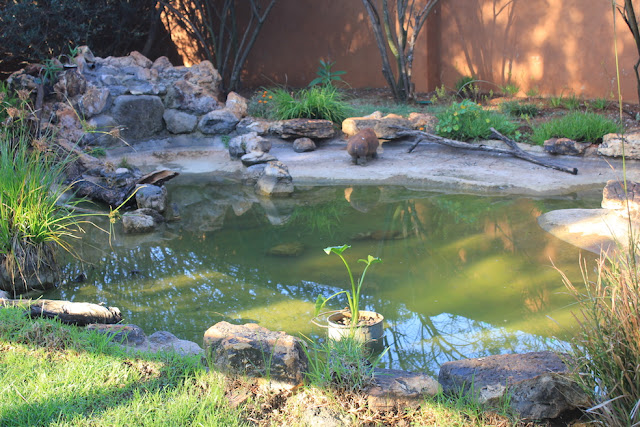The middle of winter here in S.A., and while the rest of the garden is snoozing, the Cape Reed Grass is growing as if it's spring, sending out new shoots and looking absolutely lovely! Until the chickens discover this new delight, that is. As you can see from the old growth, this plant is their favourite to climb on top of. I've had a close look inside, to see if there's anything special that they might be feeding on, worms, grubs, something, but I couldn't find anything. And I got pricked to boot, those little stalks are firm and hard! Maybe they get a good tummy massage... Mmmmm.....
My garden is definitely looking worse for the wear - every bit of greenery (as you can see on the Sword fern on the left) is being utilized by my chooks seeing as the lawn is mostly dead and brown. They're great grazers, chickens, and besides insects and their daily diet of corn, they spend the rest of the day snacking on the tender little shoots on the lawn.
And it’s that time of the year again – winter, dry grass and veld fires. And even though all our fire breaks have been done and the grass is very short, a strong wind fanned the flames to sometimes huge proportions, picking up pieces of the flames and throwing them into the air like dancing angels.
One of our workers seemingly fighting a losing battle trying to stop the fire from spreading on our smallholding. To the right outside the pic are several other workers also trying their best. One of the drawbacks of being on a farm or smallholding is no municipal services like refuse collection or fire brigade services, even though we do pay our fair share of rates and taxes!
The aftermath - this fire spread from our neighbour’s property (the yellow house) through our property, instantly leaving the landscape charred and little animals fleeing for their life.
As soon as the land cooled off a bit, the Herons, Egrets and Plovers were out in force, snacking on crispy tit-bits
This Black-headed Heron (Ardea melanocephala) is a regular summer visitor to our smallholding and doesn't get particularly perturbed by being photographed. It often feeds in shallow water, spearing fish or frogs with its long, sharp bill. It will also hunt well away from water, taking large insects, small mammals, and birds. It will wait motionless for its prey, or slowly stalk its victim. Both sexes are alike, so I have no idea whether this is a male or a female.
The Karoo Thrush and his/her mate are still hard at work annexing my Robin's territory, finishing the fruit I put out before Robbie even knows it's there.
My pond has sprung a leak, right at the bottom, and at the worst possible time in this freezing weather.
This is how much it has drained so far. Next step is to scoop out the last bit of water (being careful and keeping an eye open for any aquatic wildlife, there are quite a few water scorpions, water beetles and frogs in there), repair the leak, give it a couple of days to dry and then fill it up again, but I'm waiting for a day a bit warmer than 16℃!
“Thy breath be rude," William Shakespeare famously told winter in As You Like It, invoking a common complaint about the season: winter is cold, windy, bleak, awful, a common outlook still persisting today. But I don't agree. Cold, yes, awful, no. I think the trees enjoy the well-earned rest, all the birds in my garden carry on about their daily business as usual and it is invigorating digging and doing chores when the weather is cooler.














































